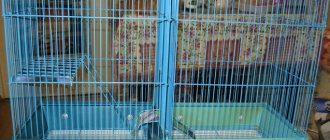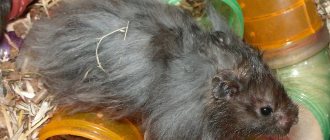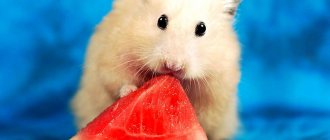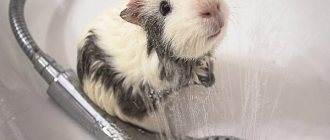Dzungariki live alone and zealously defend their territory, not allowing anyone into it, not even members of the opposite sex. This means that breeding Djungarian hamsters at home is possible only at certain times and under favorable conditions.
Let's find out what the owner needs to do in order to regularly receive healthy offspring from a furry couple.
How to keep a couple before mating: together or in different cages
Hamsters of this species reproduce well, and in captivity they are able to do this throughout the year. However, for this process they need to create certain conditions. So, before mating, it is better to keep the female and male in different cages, since they can show aggression towards each other - they will fight for territory. They need to be combined in one cage only for the duration of mating.
Note that peaceful coexistence of a boy and a girl in the same room is possible, but this is quite rare. If you do not have the opportunity to buy another cage, then you can place the female with the male for a while. Who knows, what if your couple will be on the list of those rare ones who live in peace and harmony. If the experiment fails, then it will still be necessary to decide to purchase a new cell. It is unlikely that you will like to put up with scratches and scraps of torn fur.
Read on for tips on choosing a cage and ball for your hamster.
You can avoid conflicts if you buy a girl and a boy at the same time and at the same time place them in a new cage. In this case, one male can even get along with several females. You should avoid placing a younger female with a male who has already been living with you for some time. In this case, war cannot be avoided.
Did you know? Experienced breeders have noticed that in a territorial war between males and females, the latter almost always win, and the males are inferior to them.
At what age do jungarians begin to mate?
Puberty in hairy hamsters occurs at 1-2 months. It is better to pair with a younger male and an older female. Ideally, the boy will be 3 months old, and the girl – 4. It is at this age that the female will be ready to take care of the offspring, and childbirth will become safe for her body.
If you still do not have information on how to determine the sex of hamsters, then you can do this already a month after birth. To do this, measure the distance between the animal's anus and genitals while lying on its back. If it is 0.5-1 cm, and in the center of the abdomen there is a small bulge - the male gland, then this is a male. Already at 2-3 months you will be able to see the testicles. If the distance is less than 0.5 cm, and there are 2 rows of nipples on the stomach, then it is a female. The female is also usually slightly larger than the male.
Important! A month after birth, females and males must be placed in different cages.
How to understand that a female needs to be introduced to mating
She will indicate that the female is ready to mate by unusual behavior. Once every 4-5 days, she will often raise her tail, arch her back, and secrete a strong-smelling substance. This is how the female’s sexual activity will manifest itself, which, as a rule, coincides with the follicular stage of the sexual cycle. Scientifically, this process is called estrus, popularly called estrus. Estrus usually begins in the evenings and lasts from 4 hours to a day. At this time, the female becomes favorable to the male, so it is best now to unite them in one cage.
Pair selection
For breeding, one hamster of different sexes is purchased. To get a large number of offspring, you will need 1 male and several females. To get healthy babies, adhere to the following recommendations:
- Djungarians should not be related; hamsters are purchased in different stores.
- Interspecific crossing is avoided. This applies to dwarfs and Campbell's hamsters. They belong to the dwarf breeds and often produce quite viable offspring. But when crossing there are risks for the female, for example, a large fruit. In addition, hybrids are not valued by breeders and cannot be presented at exhibitions. In this case, some diseases of hamsters of the same breed are often transmitted to their offspring.
- The weight of an adult hamster ready for mating is about 40 g. Both future parents must be absolutely healthy. When purchasing, pay attention to the coat - in healthy hamsters it is clean and shiny, the eyes are bright, do not water, and the tail is dry.
To prevent accidental crossbreeding, hamsters are carefully examined when purchasing. Under the guise of Djungarians, both Campbell and Sungur hamsters are often mistakenly sold. It is quite easy to confuse them, especially when the animals are of a standard color.
The color of the dzhungarik is distinguished by an extended black stripe on the back and a peculiar diamond shape on the head. The eyes are always black, unlike other breeds.
There are unusual coat colors:
- sapphire (closer to gray-blue);
- red (more like tangerine);
- white with gray (pearl).
The offspring of such hamsters are valued by breeders. But in this case, you need to clarify all the nuances of genetics in advance:
- You cannot cross two “tangerines”, otherwise they will pass on the so-called lethal gene to their offspring.
- The offspring of pearl-colored hamsters will not survive either.
But you can experiment by breeding representatives of rare colors among themselves. Sometimes the offspring is quite interesting.
What conditions need to be created for successful reproduction?
To encourage hamsters to mate after uniting them under one roof, you should place a lamp in the immediate vicinity of the cage and direct the light from it into the cage. In this case, the animals will look for a dark corner in their home. This will certainly bring them closer.
The best option for mating would be a separate cage, carrier, or box . This way you can avoid conflict. If this is not possible, then the female is placed with the male, and not vice versa.
The mating cage should be spacious. The room temperature is not lower than 20°C and not higher than 25°C. The cage should be installed in a secluded place where there are no drafts, noise, heating devices, and away from other pets. It is advisable to remove all gaming accessories from it.
Find out more about hamsters: what breed of pet hamster to choose, how long do hamsters of different breeds live, how to train a hamster to respond to its name.
Do not abandon animals immediately after joining without supervision. If a serious fight breaks out, they will need to be seated. You can leave them alone only if it is clear that they like each other.
Since after conception the female will begin to build a nest, she needs to put materials in the cage - rags, cotton wool, clean paper, hay. Placing newspapers in the cage is strictly prohibited.
Breeding hamsters at home: preparation and care - Breeding
Hamsters are quite calm and unpretentious animals that simply cannot help but evoke affection. Before you have such a pet in your home, you should familiarize yourself with the intricacies of keeping and caring for them. Hamsters don’t take up much space, and they don’t cause much trouble.
You can keep them in a metal cage (rodents will sooner or later damage wooden rods and escape) or in a terrarium. But put jars, buckets or boxes aside.
You should not allow hamsters to roam freely around the apartment: firstly, miniature animals easily get lost, and secondly, they gnaw on everything they can get their teeth into.
Arrangement of the cage
The monastery should be quite spacious; sawdust, odorless corn and wood filler, coarse sand should be placed at the bottom, but cotton wool and shreds should not be placed in the cage.
A shelter is required (it can be a wooden house or an upside-down clay pot with a hole). You can train rodents to go to the litter tray - there are even special toilets with litter on sale.
The sooner you start training, the greater the likelihood of success; it is almost impossible to retrain an adult.
To prevent the animal from getting bored, it would be good to purchase climbing tubes, build “minks”, ladders, a wheel is also useful for hamsters, but it should not be mesh or slippery.
It is better to choose an adjustable, drip-type drinking bowl, since hamsters like to turn the drinking bowl over or splash water out of it.
The feeder must be securely attached to the grate or be heavy so that the animal cannot turn it over.
Can you imagine a hamster without a pantry? – In some part of the cage, your pet will definitely equip itself with storage, where it will hide part of the food “in reserve.” When cleaning the cage, be extremely careful and do not take away the hidden food, otherwise the animal will be really stressed.
Hamster nutrition
The main part of the diet is various grains and cereals, often ready-made mixtures include: wheat, oats, sunflower seeds, peas, and some types of nuts.
Pets love pieces of vegetables and fruits: apples, pears, bananas, lettuce, carrots, tomatoes, pumpkins, cucumbers, squash, zucchini.
You should not give rodents bread, cabbage, potatoes, citrus fruits, persimmons, spicy or too sweet foods.
How do Djungarian hamsters mate?
Sexual intercourse among Djungarians lasts on average about 5 minutes. In general, the process of addiction and familiarization occurs within 20-30 minutes.
Djungarian hamsters usually mate in the dark. The male approaches the female several times with short breaks.
A couple should be placed in different cages when they have lost interest in each other. However, keeping them together for longer than 45 minutes is not recommended.
Do not worry if after mating the male lies down, barely breathing - sexual intercourse requires a lot of energy, so the animal needs time to recuperate. After mating, both the female and the male should be well fed with their favorite treats in the feeder.
Be prepared that it will take several matings to conceive . If 5 days after the first mating the hamster comes into heat again, the mating will need to be repeated. If estrus did not occur, and after some time the girl began to gain weight (usually the tummy becomes slightly noticeable after 10 days), then conception was successful.
Video: reproduction of Djungarian hamsters
Calculating the time of mating
The Djungarian hamster, Syrian and representatives of other breeds are crepuscular animals, which is why they prefer to breed at night. But not only the daily rhythms of these animals are important, but also the individual cycles of the female. While the furry Don Juan is ready to mate any day, the female shows sexual activity only during estrus.
Breeding hamsters at home depends on how correctly you calculate the time to introduce the male. But this is not easy to do, you have to seize the moment, because the female’s readiness lasts only 4-12 hours, and after that there is a break for 3-5 days. Typically, estrus begins in the evening, so you only have one night to mate your hamsters.
Here are the signs by which you can determine when a female is in heat:
- the pet becomes too active;
- small mucous discharge appears under the tail;
- often the mucus has a peculiar smell that attracts males;
- the hamster tries to bend her back, spreading her paws, while her butt and tail lift up a little;
- The female reacts loyally to the approach of the male.
What to feed a pregnant female
A pregnant hamster needs to create comfortable conditions, ensure complete peace and absence of stress. Remember that stressful situations can have a detrimental effect on the offspring, even to the point of a distraught mother devouring her children.
The hamster should also be provided with good nutrition. At this time, her diet should contain a lot of fruits, vegetables and products containing protein, which is so necessary during the development of the offspring in the womb . The latter include:
- egg white;
- chicken meat (boiled);
- baby food with meat;
- dairy products.
Learn more about hamster nutrition.
Also, at this moment the female urgently needs to replenish her body with minerals. To do this, place a chalk stone in the cage.
Important! Good nutrition for the mother will guarantee that she will not bite the babies to death.
.
Pregnancy
It is quite difficult for an ignorant person to determine whether a Djungarian hamster is pregnant. It is almost impossible to understand that the crossing was successful and conception occurred in the first 10 days.
The Djungarian hamster's belly does not increase until the middle of gestation, and the pet behaves as usual. But an attentive owner can still determine pregnancy by the following signs:
- Decreased activity. The hamster moves more smoothly, carefully, and stays in the house more often, even at night.
- Increased appetite. Dzungarik eats more than usual.
- In the second half of pregnancy, the female begins to build a nest for her future offspring. She fusses and drags building materials - paper, napkins - into one of the corners of the cage or into the house. It is important to make sure that she has all this in sufficient quantity.
- Towards the end of the pregnancy, the Djungarian hamster gains a little weight. His belly is rounded, and this is already visible to the naked eye.
Feeding and caring for a hamster during pregnancy
Pregnancy lasts about 21 days. About a week before the end of the gestation period, it is necessary to do a general cleaning of the cage - replace the filler, wash and disinfect the tray, feeder and drinking bowl. Then such an opportunity will arise only when the little Djungarian hamsters open their eyes.
Attention! During the breeding season, the female is sensitive to stressful situations. She should not be disturbed and protected from loud and harsh sounds.
It is important to feed your hamster properly. During the breeding season, the dwarf should receive more protein and vitamins. In addition to the grain mixture, he should be given low-fat cottage cheese, egg whites, sprouted grains and fresh herbs. The diet must include vegetables - carrots, pumpkin, cucumbers, cauliflower.
How many hamsters are born to Djungarians?
A female Djungarian hamster is maximally capable of bearing 18 babies. Usually one individual has from 5 to 9 children.
Under no circumstances should you interfere with the birth process. It is better not to approach the cage at all, so as not to scare off the female. Childbirth lasts from 1 to 2 hours. The intervals between babies coming out are on average about 15 minutes.
Newborns are born tiny, bald and blind. Babies' eyes open after 2 weeks.
Childbirth
The approach of childbirth is indicated by a lack of appetite and increased thirst in the female. She almost never leaves the nest, as she feels that the cubs will soon be born.
Childbirth in Djungarian hamsters begins on the 20-22nd day of pregnancy. This happens mainly at night. There are 4-6 cubs in a litter. During childbirth, females do not need outside help. Complications are rare.
When contractions begin, the hamster sits on her butt and bows her head over her belly. With the help of her teeth and front paws, the female helps each cub exit the birth canal. She ruptures the membranes, gnaws the umbilical cord and licks the babies. Childbirth lasts 1.5-2 hours. The kids come out at intervals of 10-15 minutes.
Attention! The hamster eats non-viable or stillborn babies. There is nothing wrong with this - this is how the mother cleans the nest of biological waste and takes care of feeding healthy jungarians.
Care of offspring
After giving birth, the mother needs rest - at least for a week. After this time, she will again be ready to mate and conceive.
A nursing mother will need good nutrition and a constant supply of clean water . It is advisable to purchase special food at a pet store so that the hamster’s breast milk is as rich as possible in the vitamins and minerals necessary for the normal development of healthy offspring.
The cage where the babies are located must be spacious - at least 50 by 30 cm. The temperature in the room where the babies live must be maintained at 21-25°C . The house with newborns should be in a shaded, quiet place.
Thus, the owner must create all favorable conditions for the new mother, but not interfere in the process of caring for the babies.
If the mother nevertheless abandoned the cubs, then you need to try to feed them yourself. For this you will need baby formula. However, the chances of survival for abandoned babies are low.
Possible problems and complications
Djungarian hamsters often have health problems during pregnancy and childbirth:
- Toxicosis . It is extremely rare among Djungarians, but unlike people, it is dangerous for a pregnant female. In this case, toxicosis develops during childbirth and even after it. There is no treatment, so it is deadly for the mother (and often for the offspring).
- Pathologies of childbirth . Before mating hamsters, be sure to pay attention to their age. This is especially true for females older than one year. By this age, their pelvic organs lose elasticity, which makes it more difficult for them to give birth. If there are few cubs (2−3), then they are larger than usual. In such a situation, the only way to save the hamster and its offspring is through surgery.
- Fetal death . This is caused by an infection or genetic disease. To save the dwarf, you also cannot do without surgery.
- Endometritis . The first symptoms of the disease are bloody discharge with an unpleasant odor that does not stop for several days. This sign often indicates the presence of a dead fetus inside.
- Mastitis . Females feed their babies on their own, and often no problems arise. But if during lactation signs such as fever, redness and enlargement of the mammary glands, and loss of appetite are observed, this may indicate mastitis.
If any strange symptoms appear during pregnancy or childbirth, you need to show your Djungarian hamster to a veterinarian.
Is it possible to pick up small jungarians?
Experienced breeders do not advise touching or picking up babies until they reach two weeks of age. Also, until this time, it is worth climbing into the cage with your hands less often, only to carry out the necessary manipulations of replacing water and providing food. The litter is not changed at this time.
The most popular of all types of domestic hamsters is the Syrian; families with children love it.
The fact is that any careless actions can scare away the mother, and in this case she will stop fulfilling her parental responsibilities. There is a big risk that she will stop feeding the children if she smells someone else's smell on them.
When can you give away hamsters after birth?
Hamsters develop very quickly, so already at the age of one month they can be given into the wrong hands. Until the 21st day, they should be close to their mother. Then, no later than the 28th day, they should be removed. They must live in a separate cage for some time before being sold. The new owner should be given some bedding from the old cage and food so that the babies quickly adapt to an unusual place - a familiar smell and familiar food will reduce stress.











